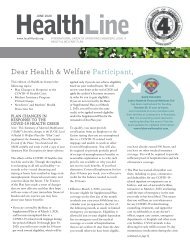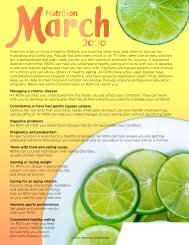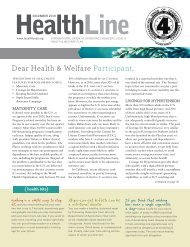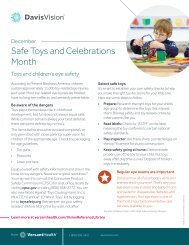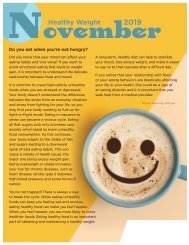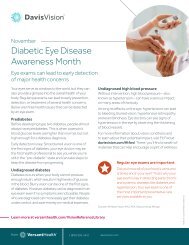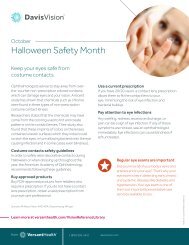BCBS September
Create successful ePaper yourself
Turn your PDF publications into a flip-book with our unique Google optimized e-Paper software.
Multivitamins<br />
Your body needs about 40 different vitamins and<br />
minerals each day for optimal health. It can be<br />
difficult to get all of this from food alone. We are<br />
often in a hurry and do not consume enough fruits,<br />
veggies, whole grains, or low-fat dairy to meet the<br />
minimum daily requirements for vitamins<br />
and minerals. A daily multivitamin can often help<br />
with any nutritional deficiencies that may occur.<br />
A multivitamin is the safest and simplest way to<br />
help get the right amounts of vitamins and minerals<br />
your body needs. Taking individual vitamins or<br />
supplements can easily lead to overdose, because<br />
nutrients can be toxic if too much is consumed.<br />
Unless your provider prescribes specific vitamins,<br />
a multivitamin each day is the best way to get the<br />
extra nutrients you need.<br />
There is a wide variety of multivitamins available<br />
and choosing the right one may be challenging.<br />
Talking with your provider and reviewing the percent<br />
of Daily Values (DV) for each nutrient is a good<br />
place to start. Avoid ingesting nutrients above the<br />
recommended daily limit. Your provider can also<br />
assist you in choosing the multivitamin that is right<br />
for you. Below are some tips that might help you<br />
choose.<br />
Choose a vitamin that:<br />
• has no more than 3,000-3,500 International Units (IUs)<br />
of retinol or vitamin A<br />
• has the USP (United States Pharmacopeia)<br />
symbol of quality on it<br />
Be cautious of:<br />
• additives, such as herbs, which make vitamins more expensive<br />
and are usually unnecessary<br />
• vitamins that provide more than 100% of the DV<br />
for any one nutrient<br />
Taking a daily multivitamin is not intended to correct a bad<br />
diet. It should be used as a supplement to make up for minor<br />
deficiencies that could eventually lead to chronic diseases<br />
if left untreated.<br />
Source: NIH.gov, WebMD.com
A health condition that lasts for 1 year or more, requires ongoing medical care, and/or limits<br />
your daily activities can be defined as a chronic disease. There are some behaviors that<br />
can greatly increase your risk of developing a chronic disease such as tobacco use and<br />
exposure, poor nutrition, lack of physical activity, and excessive alcohol use. Complete the<br />
activities below to combat unhealthy behaviors and build healthy habits. Your goal is to get<br />
5 in a row!<br />
Source: NIH.gov, WebMD.com<br />
Try a fruit or a<br />
vegetable that<br />
you have never<br />
eaten before<br />
Take a<br />
multivitamin<br />
each day for<br />
30 days<br />
Leave out the<br />
salt to lower<br />
your sodium<br />
intake for 30<br />
days<br />
Do squats during<br />
commercial<br />
breaks anytime<br />
you’re watching<br />
TV this month<br />
Add an<br />
extra fruit or<br />
vegetable to<br />
each meal you<br />
make this month<br />
Park as far away<br />
from the door as<br />
possible every<br />
time you go<br />
shopping this<br />
month<br />
Eat only fruit<br />
and/or veggies<br />
for snacks for<br />
30 days<br />
Take a 1 mile<br />
nature walk<br />
or hike<br />
Make salad one<br />
of your meals 2<br />
times each week<br />
this month<br />
Pack your own<br />
healthy snacks<br />
for any day trips<br />
you take this<br />
month<br />
Give up<br />
all sugary<br />
beverages for<br />
30 days<br />
Don’t eat fast<br />
food & cook<br />
meals at home<br />
for 30 days<br />
Tobacco<br />
& alcohol free<br />
or complete<br />
a cessation<br />
program<br />
Practice mindful<br />
eating and be in<br />
the moment at<br />
every meal this<br />
month<br />
Swap out your<br />
bread with a<br />
whole grain<br />
option whenever<br />
possible this<br />
month<br />
Visit your<br />
provider for an<br />
annual physical<br />
if you haven’t<br />
already this year<br />
Use the stairs<br />
instead of the<br />
elevator every<br />
day this month<br />
Keep a full water<br />
bottle with<br />
you every day<br />
this month for<br />
hydration<br />
Do 30 minutes<br />
of cardio 3 days<br />
each week this<br />
month<br />
Set timers every<br />
day this month<br />
to take breaks at<br />
work for a quick<br />
walk or stretch<br />
Do yoga, or<br />
another low<br />
intensity workout,<br />
1 day each week<br />
this month<br />
Clean out your<br />
fridge & stock it<br />
with fresh fruits<br />
and veggies for<br />
the month<br />
Take a 30<br />
minute walk 5<br />
days per week<br />
this month<br />
Track your<br />
physical activity<br />
in a journal for<br />
30 days<br />
Keep a food<br />
journal for 30<br />
days so you<br />
can review your<br />
nutrition & look<br />
for patterns




